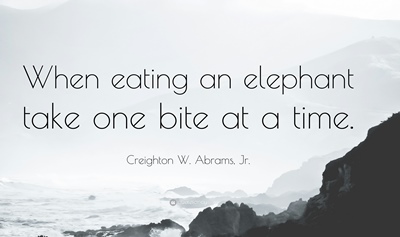Seth Godin, in his piece about how to transform higher education, writes a quote that is deeply at the core of change management in general: “If you want people to become passionate, engaged in a field, transformed by an experience?—?you don’t test them, you don’t lecture them and you don’t force them. Instead, you create an environment where willing, caring individuals can find an experience that changes them“.
 This is a fundamental recipe of change management: get people to find their own way within a general direction. It is clearly the only way to get people to get passionate. This means that they will go through a learning experience, and thus commit mistakes and explore dead-ends. This will be more messy and might take slightly more time. We need to be patient and benevolent during the process. Still that is absolutely the best solution for a sustainable and true change.
This is a fundamental recipe of change management: get people to find their own way within a general direction. It is clearly the only way to get people to get passionate. This means that they will go through a learning experience, and thus commit mistakes and explore dead-ends. This will be more messy and might take slightly more time. We need to be patient and benevolent during the process. Still that is absolutely the best solution for a sustainable and true change.
Never underestimate the power of passion and willingness. It just needs the space to grow and the time to flourish. Let that space and that time be.



 Eric Ries goes further: “According to this broad definition, anyone—no matter their official job title—can be cast unexpectedly into the waters of entrepreneurship if the context of their work becomes highly uncertain. I argued that entrepreneurs are everywhere—in small businesses, mammoth corporations, health care systems, and schools, even inside government agencies. They are anywhere that people are doing the honorable and often unheralded labor of testing a novel idea, creating a better way to work, or serving new customers by extending a product or service into new markets”.
Eric Ries goes further: “According to this broad definition, anyone—no matter their official job title—can be cast unexpectedly into the waters of entrepreneurship if the context of their work becomes highly uncertain. I argued that entrepreneurs are everywhere—in small businesses, mammoth corporations, health care systems, and schools, even inside government agencies. They are anywhere that people are doing the honorable and often unheralded labor of testing a novel idea, creating a better way to work, or serving new customers by extending a product or service into new markets”. Of course this process is at the same time frustrating (all issues don’t get addressed, only the priority ones) and there is a definite risk of creating a local optimized solution that is not optimal at all for the entire system. However it is often the only way to progress into action.
Of course this process is at the same time frustrating (all issues don’t get addressed, only the priority ones) and there is a definite risk of creating a local optimized solution that is not optimal at all for the entire system. However it is often the only way to progress into action.





